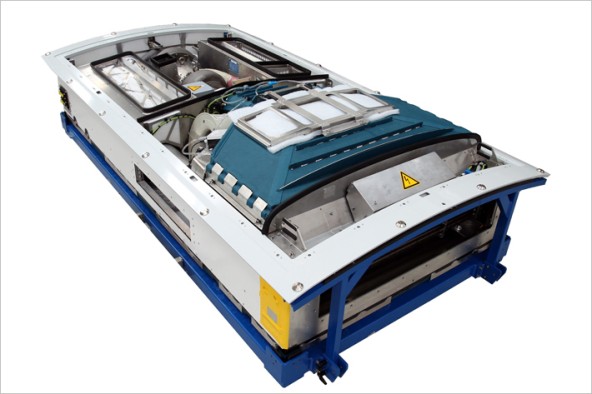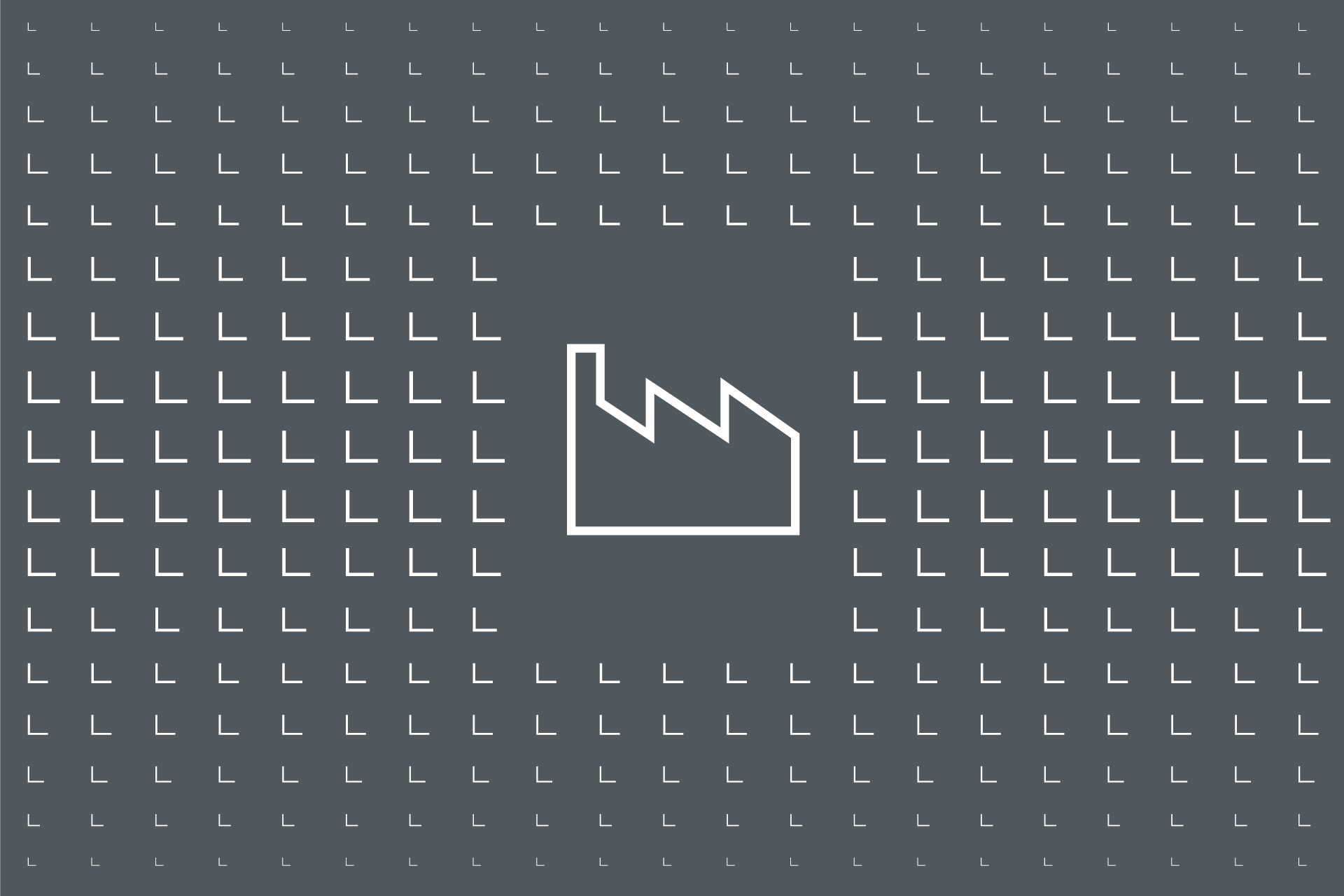Air conditioning systems
Liebherr-Transportation Systems specializes in the development, design, test, production, supply and service of heating, ventilation and air conditioning systems (HVAC) for driver´s cab and the passenger saloons. These systems also include power supply, pressure protection, air ducts, diagnosis and control equipment. They are installed in high speed, inter-city, commuter, subway and urban rapid trains as well as in trams.

Liebherr’s air conditioning saloon unit for a train operated in the Greater Paris "Ile de France" region
Liebherr-Transportation Systems offer conventional air conditioning systems with vapor cycle using traditional synthetic refrigerants. Liebherr also offers systems with CO2 as well as non-ozone depleting solutions where air is used as the cooling medium by means of an air cycle system. Liebherr’s air conditioning systems feature high output density, small mass and low weight, high reliability and availability as well as low energy consumption and noise emissions. They can be delivered either as compact modules or systems.

Liebherr’s air cycle air conditioning unit for the ICE 3.1
Liebherr is the only supplier in the industry who develops the air cycle machine in-house - thus being the expert in air cycle air conditioning.
Air cycle air conditioning systems work with air as cooling medium and are therefore totally environmentally benign.
Low lifecycle cost
The air cycle system is by far the air conditioning system that allows to reach the lowest life cycle cost (between 20 and 40 per cent lower than traditional technologies) when considering the rail vehicle’s total operation lifetime (more than 30 years).

Liebherr’s air cycle air conditioning system architecture
Open loop process
The systems operate either with an open loop or with a closed loop architecture. In any case they are based on the principle of expanding the air through a turbine to bring its temperature down.
In comparison with the closed systems that are now available on the market, the advantage of the open loop process is that in case of any minor air leakage which may develop in time, the system will continue to function with only a minor reduction in cooling efficiency. The heat exchange with the air supplied into the saloon continues independently and is separated from the air cooling process. The pen loop process offers the largest possible resistance to defects and the highest reliability with a smaller number of components.
Main components
Liebherr’s air cycle air conditioning systems consist of four main components only:
- supply air fans for air movement,
- a motorized air cycle machine/turbine (the process air is expanded here and therefore cooled),
- a heat exchanger (the cooled air flows through it and is used to cool the warm outside air, the warm process air is compressed in the compressor and fed back to ambient),
- an electric system that uses resistive heating elements to heat the cold outside air when required.
The system’s architecture is optimized for lowest internal pressure losses, light weight and high levels of efficiency.
By clicking on “ACCEPT”, you consent to the data transmission to Google for this video pursuant to Art. 6 para. 1 point a GDPR. If you do not want to consent to each YouTube video individually in the future and want to be able to load them without this blocker, you can also select “Always accept YouTube videos” and thus also consent to the respectively associated data transmissions to Google for all other YouTube videos that you will access on our website in the future.
You can withdraw given consents at any time with effect for the future and thus prevent the further transmission of your data by deselecting the respective service under “Miscellaneous services (optional)” in the settings (later also accessible via the “Privacy Settings” in the footer of our website).
For further information, please refer to our Data Protection Declaration and the Google Privacy Policy.*Google Ireland Limited, Gordon House, Barrow Street, Dublin 4, Ireland; parent company: Google LLC, 1600 Amphitheatre Parkway, Mountain View, CA 94043, USA** Note: The data transfer to the USA associated with the data transmission to Google takes place on the basis of the European Commission’s adequacy decision of 10 July 2023 (EU-U.S. Data Privacy Framework).Video - Air Cycle Technology

Driver's cab vapor air conditioning unit
Based on its long term experience, Liebherr offers vapor cycle air-conditioning systems for wide ranging applications – from high-speed trains to light rail vehicles, for both driver’s cabs and passengers’ saloons. Either compact units or split units, roof-mounted units or floor-mounted units, they provide the highest level of comfort and feature an optimized integration into the vehicle, together with a high output density and reduced weight and noise emissions.
The vapor cycle process is basically designed as a closed loop.
The intake of the cooled air into the saloon proceeds independently from the cooling process. Suitable devices for pressure protection in the intake of fresh and exhaust air provide high comfort to passengers and the train personnel even at high speeds.

CO 2 air conditioning system
The CO2 air-conditioning system works according to the established evaporation cooling principle used in traditional air-conditioners.
It uses the natural CO2 gas as the cooling medium, which is environmentally friendlier and has a greenhouse effect 1,300 times less significant than traditional vapor cycle technologies.
CO2 does not damage the ozone layer and does not require reprocessing. It is not flammable under any conditions.
The outstanding feature of the CO2 air-conditioning system is that it is exceptionally suitable for being used as a heat pump. While operating in heating mode, this brings a substantial energy saving in comparison with traditional systems. Due to the thermodynamic properties of CO2 and the high energy density, very compact design solutions are made possible with the CO2 air-conditioning technologies.
By clicking on “ACCEPT”, you consent to the data transmission to Google for this video pursuant to Art. 6 para. 1 point a GDPR. If you do not want to consent to each YouTube video individually in the future and want to be able to load them without this blocker, you can also select “Always accept YouTube videos” and thus also consent to the respectively associated data transmissions to Google for all other YouTube videos that you will access on our website in the future.
You can withdraw given consents at any time with effect for the future and thus prevent the further transmission of your data by deselecting the respective service under “Miscellaneous services (optional)” in the settings (later also accessible via the “Privacy Settings” in the footer of our website).
For further information, please refer to our Data Protection Declaration and the Google Privacy Policy.*Google Ireland Limited, Gordon House, Barrow Street, Dublin 4, Ireland; parent company: Google LLC, 1600 Amphitheatre Parkway, Mountain View, CA 94043, USA** Note: The data transfer to the USA associated with the data transmission to Google takes place on the basis of the European Commission’s adequacy decision of 10 July 2023 (EU-U.S. Data Privacy Framework).Green technology for railway vehicles
By clicking on “ACCEPT”, you consent to the data transmission to Google for this video pursuant to Art. 6 para. 1 point a GDPR. If you do not want to consent to each YouTube video individually in the future and want to be able to load them without this blocker, you can also select “Always accept YouTube videos” and thus also consent to the respectively associated data transmissions to Google for all other YouTube videos that you will access on our website in the future.
You can withdraw given consents at any time with effect for the future and thus prevent the further transmission of your data by deselecting the respective service under “Miscellaneous services (optional)” in the settings (later also accessible via the “Privacy Settings” in the footer of our website).
For further information, please refer to our Data Protection Declaration and the Google Privacy Policy.*Google Ireland Limited, Gordon House, Barrow Street, Dublin 4, Ireland; parent company: Google LLC, 1600 Amphitheatre Parkway, Mountain View, CA 94043, USA** Note: The data transfer to the USA associated with the data transmission to Google takes place on the basis of the European Commission’s adequacy decision of 10 July 2023 (EU-U.S. Data Privacy Framework).


